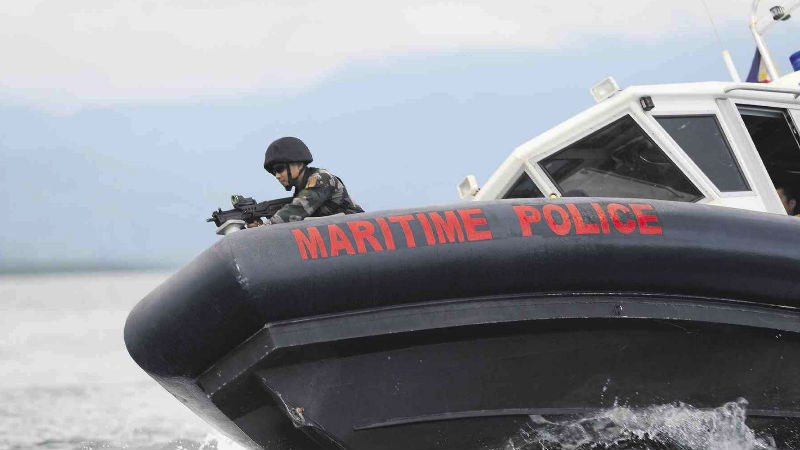
MARITIME MUSCLE Members of the Philippine Maritime Police special boat unit maneuver a US-made gunboat as they simulate the apprehension of poachers during a training exercise off Honda Bay in Puerto Princesa City in this photo taken on June 6. The gunboat packs a top speed of more than 83 kilometers per hour (45 knots) and has the capability to operate at night and is equipped with a radar. It is manned by police officers who underwent special training from US Navy Seals. AFP
HONDA BAY, Palawan—After a short, intense chase, two Philippine Maritime Police gunboats catch up with an illegal fishing vessel and circle it like menacing sharks, their armed commandos poised to rappel onboard.
“Their first reaction is to flee, but they stop once they realize they cannot outrun us,” the boat captain, John Rey Zumarraga, said during a training exercise in Honda Bay off the western island of Palawan.
With top speeds of 83 kilometers an hour (45 knots), modern radar systems and elite Marine officers, the 10-meter Special Boat Unit vessels are bad news for illegal fishermen.
Set up four years ago with funding from the US government, which also donated the gunboats and provided Navy Seal training, the unit’s mission is to patrol the nearly 2,000-km coast of the strategically located province.
Combating human trafficking is one part of its mission, but most of its time and resources are spent on trying to stop poaching of rare fish and other endangered wildlife in and around Palawan, which lies astride the South China Sea.
“Without those (gunboats) the poachers would be laughing at us,” said the unit’s chief administrative officer, Insp. Bryan Espinosa.
Achilles heel
But the unit has an Achilles heel or two: With just six boats and a tiny fuel budget, it cannot come close to adequately patroling the waters around Palawan and into the West Philippine Sea.
“The area is too vast to be patroled,” Espinosa conceded.
Nevertheless, the boat unit has been involved in the arrests of hundreds of fishermen, many of them foreigners, and busts involving Chinese and Vietnamese crews have sent diplomatic shockwaves across the South China Sea.
The unit last month arrested nine Chinese fishermen in the hotly contested West Philippine Sea waters off Palawan and seized their boat, which police said contained hundreds of endangered hawksbill sea turtles, many of them dead.
Most of the unit’s work is restricted to just off the coast of Palawan, which is indisputably Philippine territory.
However, the Chinese bust occurred more than 100 km off Palawan in a part of the South China Sea that the Philippines insists it has sovereign rights over but is also claimed by China, Vietnam, Malaysia, Brunei and Taiwan.
Indisputably PH’s
The arrests fueled a decades-long but increasingly bitter row between the Philippines and China over their competing claims to parts of the sea, and the Chinese government demanded the fishermen be immediately released.
China insists it has sovereign rights to nearly all of the South China Sea, including waters more than 1,000 km from its most southern major landmass and just 40 or 50 km from Palawan.
The Philippines has held its ground in the case, maintaining the fishermen must be brought to justice for harvesting a rare and protected species, a crime that carries a maximum penalty of 20 years in jail.
The Chinese crew have appeared in court at Puerto Princesa City for initial proceedings in what is expected to be a lengthy judicial process. They have pleaded not guilty.
They are in jail with dozens of Vietnamese arrested near Palawan’s most southern tip in waters that indisputably belong to the Philippines.
Plea bargain
Twelve of those fishermen offered last week to switch to guilty pleas and pay fines in exchange for their immediate release. The chief Palawan state prosecutor, Alen Rodriguez, said plea bargains were common.
“Bringing about convictions is quite easy, especially as they often resort to plea bargains,” Rodriguez told Agence France-Presse (AFP).
In 2011, the unit was also involved in a joint operation with the military that led to the arrest of 122 Vietnamese, the biggest illegal fishing bust in recent memory. They served jail terms of about six months, then were sent home.
Rodriguez said most foreigners charged with illegal fishing served sentences ranging from six months to four years.
Scarce fish
The Chinese detained last week face longer prison terms because their case involves an endangered species, rather than just illegal fishing.
Fishermen from China, Taiwan, Malaysia, Indonesia, the Philippines and Vietnam have for centuries shared the South China Sea’s riches, mostly peacefully.
But in recent decades, competition for increasingly scarce fish stocks has heightened as populations in Asian nations have boomed, forcing fishermen to travel further from home and closer to foreign coasts for their hauls.
“They know fully well that they are fishing beyond their territorial waters. Their vessels are equipped with GPS (global positioning system),” said the boat unit’s spokesman, Insp. Raymond Abella.
Not enough
The unit is expanding, with a new station being built near Malaysia and another one planned for the sea border with Indonesia.
However, Abella conceded this still would not be nearly enough to counter the growing problem of foreign fishing incursions.
“Palawan has a lot of resources that are no longer available where they come from, and it is relatively easy to get them. They know that policing here is not as strict, that’s why they continue to come here,” he said.
There are no police gunboats to patrol the rest of the country’s coastline, the fourth longest in the world.
The safeguarding of marine resources along the rest of the Philippines’ coastline is left to the poorly equipped Navy and Coast Guard, which is generally preoccupied with other duties.
Originally posted: 12:13 pm | Tuesday, June 17th, 2014
RELATED STORIES
Navy bases for defense of West Philippine Sea suffer lack of funds
China demands PH to withdraw from ‘illegally seized’ islands

